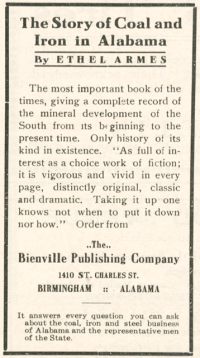The Story of Coal and Iron in Alabama
The Story of Coal and Iron in Alabama is a 1910 history written by Ethel Armes comprehensively detailing the rise of the Birmingham District as an industrial region and of Birmingham as its commercial center.
While published, begrudgingly, under the auspices of the Birmingham Chamber of Commerce, the initiative for the project was begun by Armes shortly after she arrived in the city as a Birmingham Age-Herald reporter in 1905. In 1907 then-Chamber president Robert Jemison Jr encouraged her and formed a committee, chaired by Truman Aldrich, to support Armes' research. That connection gave her access to corporate offices as well as mines, factories and industrial plants. The project was undertaken while many of the pioneers of industrial development were still active, and Armes took advantage of the opportunity to conduct extensive interviews and examine sites first hand. She also uncovered numerous previously-unknown and now lost documentary sources.
She used her skills as a journalist to craft a riveting narrative from her source material, earning effusive praise from the local press and solid reviews from national critics. She displayed unexpected objectivity for a work whose commercial niche was alongside heavy volumes of unbridled boosterism. Her critics have acknowledged her ability to bring a wide array of primary sources to bear, but question her omission of unpleasant conflicts such as the suppression of organized labor or the employment of leased convicts. Furthermore, while she took pains to paint realistic portraits of the tycoons which are the central characters of the book, her failure to look beyond those heroic personalities and make more of the contributions of the nameless has been another source of critical complaint. She compensated for some of those omissions in an incisive article in The Survey of January 6, 1912 and in her address to the United Mine Workers in 1913.
The 581-page tome was illustrated with numerous photographic and lithographic plates, bound in leather with gold leaf. After Jemison's term as president ended, there was less support for the publication in the Chamber. Secretary Joseph Babb argued against the project and funds which had been promised to support Armes' work were reduced. Frank Nelson Jr supported the work, however, and it was eventually published by the Bienville Publishing Company "under the auspices of" the group. That business shared an address with Armes' mother, Lucy. The University Press in Cambridge, Massachusetts actually printed and bound the book. Copies were abundant enough it was advertised for sale in regional magazines months later, and Armes was still seeking help in getting the work into bookstores in 1921.
In a 1949 column, Alabama Journal editor C. M. Stanley recounted that many of the still-boxed books, stored in the basement of the Chamber of Commerce Building, were lost to a fire. He also reported that Lincoln Reserve Life Insurance Company president Jesse Stallings had the remaining cartons disposed of after his company acquired the building in the 1920s. Publisher and rare book dealer Patrick Cather has argued that first editions are not as scarce as they are often made out to be, and that tales of their consignment to fire and waste amount to undocumented legends.
The publication entered the public domain in 1948. Facsimile reprint editions were published in 1972 by the Book Keeper's Press and in 1987 by Leeds's Beechwood Books imprint. The University of Alabama Press published a paperback edition of the book as part of its "Library of Alabama Classics" series in 2011. That edition featured a new preface by Jim Bennett.
Chapters
- The Planting of the Seed
- Records of Early Growth
- First Furnace and First Railroad
- Early Records of Jefferson and Walker Counties
- Iron Making and Coal Mining in Tuskaloosa County, 1830-1861
- Bibb and Shelby Counties, 1820-1861
- Pioneer Iron Making in Northeastern Alabama, 1830-1861, and First State Geological Survey
- Early Railroad Enterprises
- Internal Conditions of State and Outbreak of War
- Confederate Arsenal and Naval Foundry
- Coal Mining in Civil War Period
- Iron Making in War Period
- Iron Making in War Period (continued), The Fall of Selma
- Resurrection of the Iron Works 1866-1870
- The Founding of a Great Workshop Town, 1869-1872
- Reconstruction of Oxmoor and Advent of Louisville and Nashville Railroad into Alabama 1872-1873
- Life Saving Measures 1873-1878
- Birmingham Militant 1876-1880
- A Chapter of Progress 1880-1886
- The Northeastern Counties 1870-1890
- The Great Boom of Birmingham 1886-1887
- More Big Business 1886. Records of Sloss Iron and Steel Company and Pioneer Mining and Manufacturing Company
- Advent of Tennessee Company into Alabama (1886) and its Early Trials and Tribulations
- A Series of Lively Incidents in the Birmingham and Sheffield Districts 1887
- The March of the T.C.I. 1888-1895
- Affairs of Birmingham District 1890-1909. Birmingham Coal and Iron Company. Dimmick Pipe Company. Southern Iron and Steel Company. Sloss-Sheffield Steel and Iron Company
- Present Day Affairs of Birmingham District (continued). History of the T.C.I. (continued), Organization of Alabama Consolidated Coal and Iron Company.
- The Making of Walker County. Pratt Consolidated Coal Company, Galloway Coal Company, Corona Coal Company, Empire Coal Company and Others
- The Triumph of the T.C.I.
References
- Armes, Ethel (1910) The Story of Coal and Iron in Alabama. Birmingham: Birmingham Chamber of Commerce
- Stanley, C. M. (November 6, 1949) "Armes Didn't Look Like a Historian." The Montgomery Advertiser-Alabama Journal, p. B-3
- Cather, Patrick (1993) Birmingham Bound: Opinionated and Often Irreverent Essays on the Fifty Most Important Books About Alabama's Largest City. Birmingham: Cather and Brown Books.
- Fazio, Michael W. (2010) Landscape of Transformations: Architecture and Birmingham, Alabama. Knoxville, Tennessee: University of Tennessee Press ISBN 9781572336872

